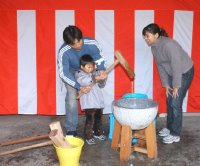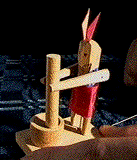. daikon 大根と伝説 Legends about radish .
:::::::::::::::::::::::::::::::::::::::::::::::::::::::::::::::::::::::::::::::::::::::::::::::::::::
Radish (daikon, Japan)
***** Location: Japan
***** Season: Various, see below
***** Category: Plant
*****************************
Explanation
Radish, Reddish, daikon 大根
Raphanus sativas
Rettich
The long big white radish (daikon 大根) was a winter staple of poor farmers. Even today it is a very popular vegetable. It is cut in small stripes and dried (kiriboshi daikon 切干大根) for later use as a staple.
The skin of gourd was also peeled and dried (kanpyoo 干瓢).
Different varieties of daikon grow at different times of the year and though the cold months usually yield the finest flavor and crispest texture, daikon as a vegetable is at market nearly year-round.
In the Miura Peninnsula, south of Tokyo, a special variety, the Miura Daikon 三浦大根
is grown. I loved to walk through the large fields of this area in winter.
Throughout Japan a kind of radish with a green neck (aokubi daikon 青首大根) is grown as a speciality.
More kigo with radish as a food are given below.
Look at radish from Miura
Look at radish with a green neck
In the Heian period, the slender upper arms of a lady were compared to a radish.
In our modern times, the thick legs of a woman are compared to a radish, daikon ashi 大根足.
. . . CLICK here for daikon ashi leg Photos !
The slender part is used for grating (daikon oroshi 大根おろし), the middle part is used for oden hodgepodge and the part toward the leaves is used for eating raw in salads. Some even eat the leaves, fried in oil.
WASHOKU VEGETABLE SAIJIKI
More kigo with RADISH
.................................................................................

futamata daikon 二股大根(ふたまただいこん)
bifurcated radish
yome daikon 嫁大根(よめだいこん)"radish like a bride"
and its relation to the deity
. Daikoku 大黒天 Mahakala
:::::::::::::::::::::::::::::::::::::::::::::::::::::::::::::::::::::::::::::::::::::::::::::::::::::
kigo for all winter
Drying Radish as winter food.
たつぷりと峡の日抱かせ大根干す
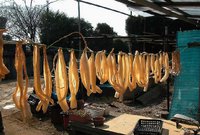
http://www.interone.jp/~touri/garo/garo.htm
daiko hiki daiko hiki だいこ引き(だいこひき)
harvesting radish
. WKD : Winter and Farmers Work with Radish
:::::::::::::::::::::::::::::::::::::::::::::::::::::::::::::::::::::::::::::::::::::::::::::::::::::
observance kigo for mid-winter
Daikodaki (daikotaki) 大根焚 Cooking large radishes
Temple Sansen-In, Kyoto, Feb. 10 - 13
三千院の初午大根焚き, 年2月10日~13日
. Daikon and temple festivals .
- about a hokku by Kobayashi Issa -
Although these long white radishes are usually called daikon ('big root') in modern Japanese, in Issa's time they were commonly called daiko, which has three syllables. This is usually the pronunciation found in haikai, since daikon is four syllables long and harder to fit into lines. Even today the old pronunciation can be found in the name of a ceremony at Ryoutokuji Temple in Kyoto to give thanks to Shinran, the founder of the temple and of the True Pure Land school of Buddhism. On Dec. 9, the Daiko-daki (Daikon Cooking) Ceremony is held, during which fresh slices of daikon radish are boiled in a broth that is given to visitors to the temple and placed before an image of Shinran.
尼達や二人かかって引大根
ama-tachi ya futari kakatte hiki daiko
. Chris Drake .
:::::::::::::::::::::::::::::::::::::::::::::::::::::::::::::::::::::::::::::::::::::::::::::::::::::
Red Radish (hatsuka-daikon 二十日大根)
By LINDA INOKI, The Japan Times, December 7, 2005
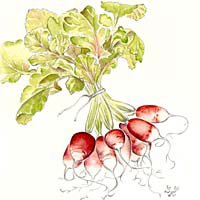
菊の後大根の外更になし
kiku no ato daikon no hoka sara ni nashi
After the chrysanthemums,
Apart from radishes,
There is nothing.
By Matsuo Basho (1644-94)
Winter offers few flowers for the poet, but Basho humorously points to the humble daikon, or Japanese White Radish, to evoke the coldness of earth, root and man. However the little hatsuka-daikon is a warm-looking radish, which is well known for its crisp, peppery roots. On the outside, these 3-6 cm roots are beautiful shades of deep red or pink, but on the inside they are pure white.
The plant (Raphanus sativus) is closely related to a widespread wild radish that grows across Europe and Asia and has been cultivated for at least 5,000 years. In fact it is said that poor people in ancient Egypt survived on bread, onions and radishes.
Through selection and natural cross-fertilization, the color of radishes has changed over the centuries from black to white to red. The variety pictured here is a two-toned French breakfast radish. However, there is even a modern hybrid, developed by the Beijing Vegetable Research Centre, which has red flesh instead of the usual white. Its name is singli mei, which means "beautiful heart." Radishes are tough, frost-resistant and grow incredibly quickly. If you plant the seeds in one month you can be eating the roots the next! That explains the Japanese name, which means "20-day daikon."
http://www.japantimes.co.jp/cgi-bin/getarticle.pl5?fe20051207li.htm
xxxxxxxxxxxxxxxxxxxxxxxxxxxxx
Daikon... Loh Bak... or Chinese radish
(Raphanus sativus radicola )
Daikon looks like a short thick pipe--beige colored, heavy, sensuous. Sliced and eaten raw, it is fresh, snappy, with a juicy crispness--halfway between a radish and a turnip in texture and bite, and with a good long range between the two.
If you get a green daikon (or a green and white one)--be sure to cook it before eating.
http://www.soupsong.com/fdaikon.html
*****************************
Worldwide use
Germany
Rettich. Radieschen.
*****************************
Things found on the way
Daruma Daikon ... a new variety
Daruma as a radish
だるま大根

:::::::::::::::::::::::::::::::::::::::::::::::::::::::::::::::::::::::::::::::::::::::::::::::::::::
daikon yakusha 大根役者 ham actor, bad actor
kabu or daikon - thus related to kabuki and the Kabuki theaters is Asakusa, Edo/Tokyo.
- quote
On August 31, 1888, it was reported that the government had granted a permit to Fukuchi Ochi (Genichiro) and others to establish a "new improved theater" at 3-chome, Kobikicho, Kyobashi-ku (present Chuo-ku Ginza). The plan attracted a great deal of attention and in the September 18 edition of The Daily Yomiuri it was revealed that the theater would be named "Kabuza."
However, the theater was eventually called "Kabukiza" for some reason, but perhaps not because "the theater should not be named Kabuza to avoid employing ham actors."
(In Japanese, kabu or daikon means radish and ham actors are referred to as daikon yakusha.) (Ref. Lamp no Shitanite by Okamoto Kido.)
- source : www.ndl.go.jp/scenery/e

source : www.muragon.net/blog1
double-daikon at the gables of the temple
Even today, large radishes are offered at
Matsuchiyama Shooten 待乳山聖天 Honryuuin 本龍院 Honryu-In
near the Sumida river.
The deity Bishamonten is venerated here as one of the seven gods of good luck.
HP of the temple
- source : members2.jcom.home.ne.jp/matuti

kinchaku gata kintama 巾着型貯金玉 money pouch in form of a kinchaku bag
amulet to keep your money
Even with the decoration of the double-radish.
. - - - Welcome to Edo 江戸 ! .
:::::::::::::::::::::::::::::::::::::::::::::::::::::::::::::::::::::::::::::::::::::::::::::::::::::
Hungry to learn more about Japan?
A TASTE OF CULTURE culinary arts program combines spicy tidbits of food lore with practical tips and skill-building lessons on how to prepare Japanese food. Programs offer a unique opportunity for foreign residents and visitors from overseas to explore and enjoy Japan's culture through its food.
A TASTE OF CULTURE
Elizabeth Andoh
Here is the newsletter of Elizabeth from December 2006:
My 30-something nephew, Shohei, just delivered 2 huge, Miura daikon radishes, their bushy, verdant tops lopped off just below where they had been connected to their firm, bulbous roots. In exchange, he carted away several boxes of nori, both seasoned and plain-toasted, two cans of taraba-gani crabmeat, five 1-liter bottles of cooking oil, several men's linen handkerchiefs, a Chanel necktie, a set of lace-trimmed hand towels, and a package of German-style sausages.
Here in Tokyo, and indeed throughout most of Japan, an easy-to-grow-and-store, cylindrical, all-purpose variety of daikon called aokubi (green-necked) has pretty much taken over the marketplace. Every once in a while, a less than perfectly formed aokubi can be seen at natural food shops, typical split into stumpy "legs." Although these firm radishes can provide fine eating both cooked and raw, they tend to be bland and often a bit woody. Other varieties such as Nerima, karami, Shogoin, or Sakurajima each have distinctive characteristics making them more suitable for some dishes than for others.
Long, slender Nerima daikon are fine when shredded in salads, but most of the crop is air-dried then made into golden yellow takuan pickles by submerging them in nuka (rice bran) paste for several months. Karami daikon is best grated, with or without a drizzle of soy sauce, and gives quite a kick to whatever food it is eaten with. Globe-shaped Shogoin daikon is wonderful thinly sliced in salads or cut in wedges and braised. Huge, bulbous Sakurajima daikon is most-often sliced into thin circles and pickled. And, a nearly 65-pound, Sakurajima daikon is listed in the Guinness Book of Records as the largest radish in the world!
My personal favorite, though, is Miura daikon, yet another regional variety. Grown primarily on the Miura Peninsula southwest of Tokyo, it is sweet-and-spicy and crisp-and-juicy when shredded (though it can get a bit watery when grated). Miura is especially flavorful when steamed and sauced with pungent miso, or soy-simmered with buri (yellowtail, buri daikon 鰤大根) or slow-stewed with fish sausages in oden. Even the peels of Miura daikon are tasty, especially stir-fried.
Ready now for a bit of anthropomorphic fun? In 1999, the toy company Takara Tomy created an animated character based on a straight-laced, split-legged radish called Aokubi daikon, and less than year later, added a fun-loving, sake-and-shochu-guzzling radish called Sakurajima daikon to what became a series of veggie-based characters.
Check out their website:
http://www.takaratomy.co.jp/products/aokubidaikon/index.html
As you place your computer cursor over a tuft of daikon greens, the root pops up. Click on the 3rd tuft from the left for an animated cartoon.
For yet more bizarre fun, click here, and scroll down to where vertical banners decorate a stage. Choose the 3rd from the left, and click on the TV screen for a series of ridiculous tanka poems:
http://www.e-revolution.co.jp/zakka/daikon/index.html
When you are ready for some serious daikon cooking and eating pleasure, take a look at my updated Seasonal Japanese Kitchen page at http://www.tasteofculture.com/ ; I include links to images of several varieties of radish, and recipes for a multi-course feast.
Seasonal Pleasures: DAIKON
Thanks, Elizabeth, for your delicious newsletter !
:::::::::::::::::::::::::::::::::::::::::::::::::::::::::::::::::::::::::::::::::::::::::::::::::::::
Vegetables entering Nirvana
By Ito Jakuchu

伊藤若冲の『野菜涅槃図』
Itoo Jakuchuu (1716 - 1800)
In the Zen sect, Buddha is sometimes represented as a large radish.
This is a nehanzu of Shakyamuni.
*****************************
HAIKU
Matsuo Basho
in the year Genroku 6
At a restaurant in Edo, in the company of the Samurai from Iga, Fujido Chobei, Shimizu Shuuchiku and Yanada Kameo.
藤堂長兵衛守壽(俳号玄虎), 清水周竹 and 梁田亀毛.
This is the hokku of Basho:
もののふの大根苦しき話哉
mononofu no daikon nigaki hanashi kana
Eating roots; talking all day with a warrior
warriors
the bitterness of pickles
in the talk
Tr. Reichhold
I ate vegetable roots and talked with samurai all day long
samurai's gathering--
their chat has the pungent taste
of daikon radish
Tr. Ueda
Eating vegetable roots, I talked all day with samurai
a samurai gathering:
pungent as a radish is
their talk
Tr. Barnhill
An excerpt from Reichhold's comment:
"...Basho uses the word 'nigaki', which means 'bitter'."
A comment by Ueda, from his biography of Basho:
"Here the poet, who was used to carefree chats among ordinary townsmen, was invited to join a
group from the ruling warrior class and found that their conversation, reflecting their neo-Confusion upbringing, was somewhat rigorous and dignified even on this informal occasion. But Basho did not alienate himself from the group; he chose to enjoy that rather stiff atmosphere, humorously comparing it to the taste of a radish."
Barnhil says that this is "
An opening hokku for a linked verse conducted with two samurai."
Larry Bole: Basho Haiku about Food
Samurai talk –
tang
of horse-radish.
Tr. Lucien Stryk
Едкая редька...
и суровый, мужской
разговор с самураем
Tr. Вера Маркова
source : dmitrismirnov
A samurai party--
pungent as daikon radish
their conversation!
source : http://www.soupsong.com/fdaikon.html
:::::::::::::::::::::::::::::::::::::::::::::::::::::::::::::::::::::::::::::::::::::::::::::::::::::
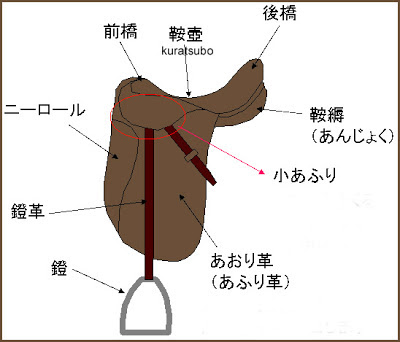
鞍壺に小坊主乗るや大根引
kuratsubo ni koboozu noru ya daiko hiki
in the saddle
a little is boy riding -
radish pullers
Matsuo Basho 松尾芭蕉, 1693

source : itoyo/basho
真岡市荒町出世稲荷の句碑
Memorial Stone at shrine Inari Jinja in Maoka town
.............................................................................
身にしみて大根からし秋の風
mi ni shimite daikon karashi aki no kaze
Penetrating deep,
the sharp taste of white radish—
winds of autumn
Tr. Blyth
quote
The speaker tastes a daikon, a white radish, which is so sharp and spicy that it seems to pierce the body. The first five syllables, “Penetrating deep” (mi ni shimite), are related not only to “The sharp taste of white radish” (daikon karashi) but to “The winds of autumn” (aki no kaze), which also penetrate the body.
The two parts of a toriawase interact in the manner of a hibiki link, in which the emotional and sensory intensity of the previous verse “reverberates” in the added verse.
The whiteness of the daikon is also echoed in “The winds of autumn,” traditionally referred to as “colorless wind” (iro naki kaze).
The fatigued metaphor of “autumn wind,” a cliché from the classical, “high” (ga) tradition, is here reenergized by the visceral, unusual metaphor of “the sharp taste of radish” (daikon karashi), a haigon from everyday, “low” (zoku) culture. The heterogeneous images combine to form a larger metaphor for the hardship and bitterness of travel.
Blyth

source : yamanoasioto
The daikon from the Kiso region with its poor soil of the mountain fields is especially pungent.
But the cold wind is even more penetrating.
Basho on the Sarashina Kiko, Aida village. With a stone memorial
四賀村会田岩井堂旧善光寺
the pungent taste of this radish
penetrates right through my body -
autumn wind
Tr. Gabi Greve
MORE - hokku about food by
. Matsuo Basho 松尾芭蕉 - Archives of the WKD .
:::::::::::::::::::::::::::::::::::::::::::::::::::::::::::::::::::::::::::::::::::::::::::::::::::::
大根引大根で道を教へけり
daiko hiki daiko de michi o oshie-keri
with a just-yanked
radish
pointing the way
Kobayashi Issa (1763-1827)
translated by David Lanoue
http://www.worldhaikuclub.org/pages/whcght_radishes/pointed_radishes.htm

persian caligraphy by Massih Talebian
xxxxxxxxxxxxxxxxxxxxxxxxxxxxx
dinner time -
the silence of monks
munching takuan
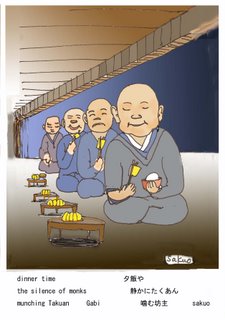
夕飯や 静かにたくあん 噛む坊主
yuhan ya shizuka ni takuan kamu boozu
(Tr. and haiga : Nakamura Sakuo)
Gabi Greve, 2005
(for takuan, see below)
xxxxxxxxxxxxxxxxxxxxxxxxxxxxx
a daikon for the snowman's nose -- rather pale
"chibi" (pen-name for Dennis M. Holmes)
*****************************
Related words
Kigo for All Winter
***** pickled leaves of radish, kukizuke 茎漬
***** pickled radish, takuanzuke 沢庵漬
..... Takuan was a famous Zen Priest, who invented this dish. It is very popular. Zen monks are supposed to eat their slices of Takuan radish without making any noise. There are usually two slices on the plate, used to carefully clear out the bolws afer eating and then munching the Takuan in silence.
If you want to know the secret of eating Takuan in silence, contact me :o) !
The Unfettered Mind. by Takuan Soho
***** boiled radish, furofuki 風呂吹
***** to pickle radish, daikon tsukeru 大根漬ける
:::::::::::::::::::::::::::::::::::::::::::::::::::::::::::::::::::::::::::::::::::::::::::::::::::::
Kigo for Early Winter
***** to dry radish, daikon hosu, daiko hosu 大根干す
***** dried radish, hoshidaikon 干大根
***** cut and dried radish, kiriboshi 切干
A speciality from Saikai town, 西海市 Nagasaki
yudeboshi daikon ゆで干し大根
cooked, dried radish stripes
:::::::::::::::::::::::::::::::::::::::::::::::::::::::::::::::::::::::::::::::::::::::::::::::::::::
Kigo for Late Spring
***** radish flowers, daikon no hana 大根の花
..... of a bright blue-purple color, a great view in spring beside the yellow rape flowers. They grow almost like weed once they have taken to a place.
suzushiro すずしろ/ 清白 radish of spring
one of the
Seven Herbs of Spring.
Haru no Nanakusa 春の七草
..........................................
***** daikon maku 大根蒔く (だいこんまく)sowing radish seeds
kigo for early autumn
:::::::::::::::::::::::::::::::::::::::::::::::::::::::::::::::::::::::::::::::::::::::::::::::::::::
***** Gutsy Radish (dokonjoo daikon) Japan.
kigo for all Winter.
:::::::::::::::::::::::::::::::::::::::::::::::::::::::::::::::::::::::::::::::::::::::::::::::::::::
WASHOKU VEGETABLE SAIJIKI
kigo with TURNIP 蕪 kabu
***** . WASHOKU
Favorite Radish Dishes from Edo
Back to the Worldkigo Index
http://worldkigodatabase.blogspot.com/
WASHOKU ... Japanese Food SAIJIKI
TAKUAN ... pickled radish from Gunma prefecture
:::::::::::::::::::::::::::::::::::::::::::::::::::::::::::::::::::::::::::::::::::::::::::::::::::::::::::::::::::::::::::
. daikon 大根と伝説 Legends about radish .
[ . BACK to DARUMA MUSEUM TOP . ]
[ . BACK to WORLDKIGO . TOP . ]
- #daikon #radish #takuan -
:::::::::::::::::::::::::::::::::::::::::::::::::::::::::::::::::::::::::::::::::::::::::::::::::::::::::::::::::::::::::::







